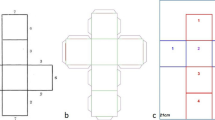Abstract
Origami folders often find themselves unable to recall the entire sequences of foldings, and origami drill books have been the only resources for them to learn to fold. However, many people have difficulties understanding symbols and operations in drill books. The purpose of this research is to design and develop a mobile augmented reality application that acts as a technological aid to origami folders. Extensive user studies have been employed at every step of the implementation. The application recognizes the current state/shape of the paper and instantly overlays the diagrams and instructions of the next step(s) on the real paper through the smartphone’s camera view. Evaluation results show that the application can successfully assist folders most of the time, and the qualitative mean score is about the same level of most mobile applications. This work will benefit a lot of origami practitioners such as those in geometry classes and intellectual development classes.
Access this chapter
Tax calculation will be finalised at checkout
Purchases are for personal use only
Preview
Unable to display preview. Download preview PDF.
Similar content being viewed by others
References
Kuribayashi, K., Tsuchiya, K., You, Z., Tomus, D., Umemoto, M., Ito, T., Sasaki, M.: Self-deployable Origami Stent Grafts as a Biomedical Application of Ni-rich TiNi Shape Memory Alloy Foil. Materials Science and Engineering: A 419(1–2), 131–137 (2006)
Smith, L.M.: Nanostructures: The Manifold Faces of DNA. Nature 440(7082), 283–284 (2006)
Nishiyama, Y.: Miura Folding: Applying Origami to Space Exploration. International Journal of Pure and Applied Mathematics 79(2), 269–279 (2012)
Randlett, S.: The Art of Origami; Paper Folding, Traditional and Modern, 1st edn. E P Dutton, June 1961
Watanabe, T., Kinoshita, Y.: Folding support for beginners based on state estimation of origami. In: Proceedings of IEEE Region 10 Conference TENCON, pp. 1–6 (2012)
Johnson, L., Brown, M., Becker, S.A., Cummins, M., Diaz, V.: NMC Horizon Reports (2015)
Unity - Game Engine. https://unity3d.com/
Qualcomm Vuforia Developer Portal. https://developer.vuforia.com/
Brooke, J.: Usability Evaluation in Industry, chap. SUS: A Quick and Dirty Usability Scale, pp. 189–194. Taylor and Francis, London, June 1996
Sauro, J.: A Practical Guide to the System Usability Scale: Background, Benchmarks and Best Practices. CreateSpace Independent Publishing Platform (2011)
Shimanuki, H., Kato, J., Watanabe, T.: Recognition of folding process from origami drill books. In: Proceedings of Seventh International Conference on Document Analysis and Recognition, pp. 550–554 (2003)
Kinoshita, Y., Watanabe, T.: Estimation of Folding Operation Using Silhouette of Origami. IAENG International Journal of Computer Science 37(2) (2008)
Kato, J., Watanabe, T., Nakayama, T., Guo, L., Kato, H.: A model-based approach for recognizing folding process of origami. In: Proceedings of Fourteenth International Conference on Pattern Recognition (1998)
Hiranabe, K.: How to make it better? - Extracting implicit knowledge in Origami (paper folding) via GSN. http://astahblog.com/2014/08/24/
Tran, Q.T., Calcaterra, G., Mynatt, E.D.: Cook’s collage: deja vu display for a home kitchen. In: Proceedings of Home Oriented Informatics and Telematics (HOIT 2005), York, UK (2005)
Zhu, K., Fernando, O.N.N., Cheok, A.D., Fiala, M., Yang, T.W., Samani, H.A.: A SURF-based natural feaure tracking system for origami recognition. In: Proceedings of 20th International Conference on Artificial Reality and Telexistence, Adelaide, Australia (2010)
Author information
Authors and Affiliations
Corresponding author
Editor information
Editors and Affiliations
Rights and permissions
Copyright information
© 2016 Springer International Publishing Switzerland
About this paper
Cite this paper
Wiwatwattana, N., Laphom, C., Aggaitchaya, S., Chattanon, S. (2016). Origami Guru: An Augmented Reality Application to Assist Paper Folding. In: Latifi, S. (eds) Information Technology: New Generations. Advances in Intelligent Systems and Computing, vol 448. Springer, Cham. https://doi.org/10.1007/978-3-319-32467-8_95
Download citation
DOI: https://doi.org/10.1007/978-3-319-32467-8_95
Published:
Publisher Name: Springer, Cham
Print ISBN: 978-3-319-32466-1
Online ISBN: 978-3-319-32467-8
eBook Packages: EngineeringEngineering (R0)




